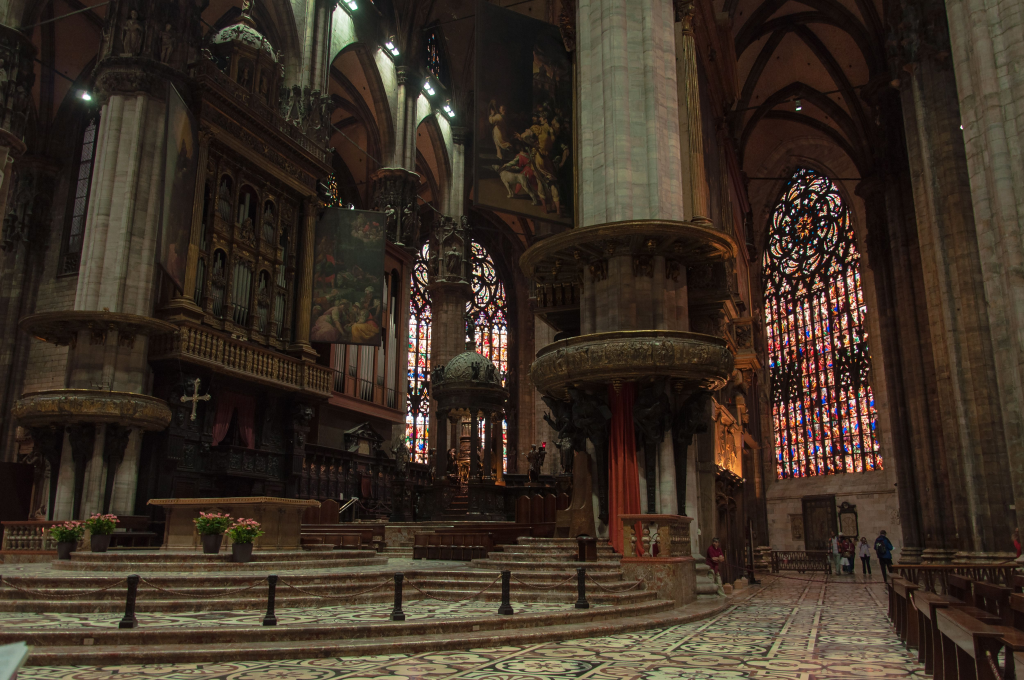The Duomo of Milan: A Stunning Example of Gothic Architecture
The Duomo of Milan is one of the most iconic buildings in Italy. It is a stunning example of Gothic architecture, and it is a must-see for any visitor to Milan.
The Duomo was built over a period of nearly 600 years, from the 14th to the 19th centuries. It is a vast structure, with a length of 157 meters (515 feet), a width of 92 meters (302 feet), and a height of 108 meters (354 feet). The Duomo is made of white marble, and it is decorated with over 3,400 statues.
The Duomo’s exterior is a feast for the eyes. The facade is divided into five naves, and each nave is topped with a rose window. The rose windows are some of the largest in the world, and they are decorated with intricate stained glass.
The Duomo’s interior is just as impressive as its exterior. The nave is 50 meters (164 feet) high, and it is lined with 52 columns. The ceiling is decorated with a series of frescoes, and the floor is made of marble.
The Duomo is a UNESCO World Heritage Site, and it is one of the most popular tourist attractions in Milan. It is a must-see for any visitor to the city.

Here are some of the architectural features of the Duomo that make it so stunning:
- The rose windows: The Duomo’s rose windows are some of the largest in the world, and they are decorated with intricate stained glass. The rose windows are located on the facade of the Duomo, and they are a major architectural feature.
- The spires: The Duomo has 135 spires, which give it its distinctive silhouette. The spires are made of white marble, and they are decorated with statues.
- The statues: The Duomo is decorated with over 3,400 statues, which depict religious figures, saints, and angels. The statues are made of marble, and they are a major architectural feature of the Duomo.
- The interior: The Duomo’s interior is just as impressive as its exterior. The nave is 50 meters (164 feet) high, and it is lined with 52 columns. The ceiling is decorated with a series of frescoes, and the floor is made of marble.
The Duomo of Milan is a stunning example of Gothic architecture. It is a must-see for any visitor to Milan.

The History of the Duomo of Milan
The Duomo of Milan is one of the most iconic buildings in Italy, and it is a UNESCO World Heritage Site. It is a stunning example of Gothic architecture, and it took nearly 600 years to build.
The construction of the Duomo began in 1386, when Gian Galeazzo Visconti, the Duke of Milan, decided to build a new cathedral for the city. The original design was by Simone da Orsenigo, but it was later modified by other architects, including Giovanni Antonio Amadeo and Francesco di Giorgio Martini.
The Duomo was built in stages, and it was not completed until 1965. The exterior of the Duomo is made of white marble, and it is decorated with over 3,400 statues. The interior of the Duomo is just as impressive, with a nave that is 50 meters (164 feet) high and a ceiling that is decorated with a series of frescoes.
The Duomo has played an important role in the history of Milan. It has been used for religious ceremonies, as a meeting place, and as a symbol of the city’s power and wealth. Today, the Duomo is one of the most popular tourist attractions in Milan, and it is a must-see for any visitor to the city.

Here are some of the key events in the history of the Duomo of Milan:
- 1386: Construction of the Duomo begins.
- 1400: The first stone is laid.
- 1418: The first spire is completed.
- 1500: The nave is completed.
- 1600: The facade is completed.
- 1700: The interior is decorated with frescoes.
- 1800: The Duomo is damaged during the Napoleonic Wars.
- 1900: The Duomo is restored.
- 1965: The Duomo is finally completed.
The Duomo of Milan is a stunning example of Gothic architecture, and it is a testament to the skill and dedication of the architects and builders who worked on it over the course of nearly 600 years. It is a must-see for any visitor to Milan.

Napoleon and the Duomo of Milan:
Napoleon Bonaparte had a complicated relationship with the Duomo of Milan. On the one hand, he was impressed by the cathedral’s beauty and grandeur, and he even ordered that it be restored after it was damaged during the Napoleonic Wars. On the other hand, he also saw the Duomo as a symbol of Milan’s independence, and he made plans to convert it into a temple of his own glory.
In 1805, Napoleon crowned himself Emperor of France in Milan’s Duomo. He saw the cathedral as a fitting venue for his coronation, as it was a symbol of Milan’s power and prestige. However, his coronation also sparked protests from Milanese citizens, who saw it as an act of occupation.
After the Napoleonic Wars, the Duomo was restored to its former glory. However, Napoleon’s plans to convert it into a temple of his own glory were never realized. Today, the Duomo remains a symbol of Milan’s history and culture, and it is one of the most popular tourist attractions in the city.
Here are some of the things that Napoleon did to the Duomo of Milan:
- He ordered that it be restored after it was damaged during the Napoleonic Wars.
- He made plans to convert it into a temple of his own glory.
- He crowned himself Emperor of France in the Duomo in 1805.
Napoleon’s relationship with the Duomo of Milan is a complex one. He saw the cathedral as a symbol of Milan’s power and prestige, but he also saw it as a threat to his own authority. His plans to convert it into a temple of his own glory were never realized, but his coronation in the Duomo remains a significant event in Milan’s history.
Shayne Heffernan








